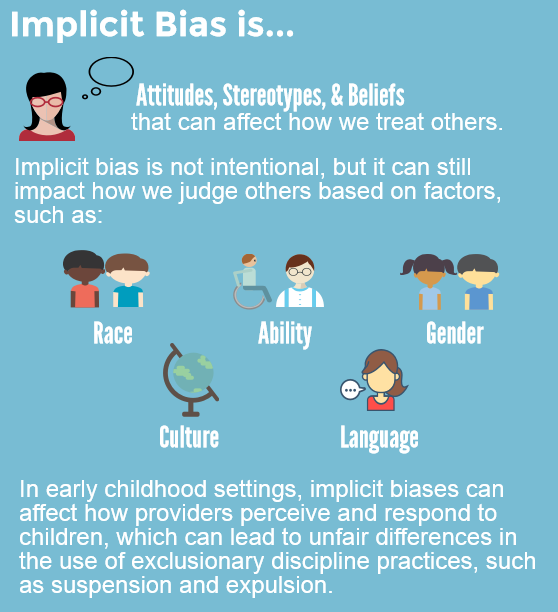Explain the Difference Between Implicit Biases and Stereotypes
What are your personal thoughts on the issue covered by the article. We have a bias when rather than being neutral we have a preference for or aversion to a person or group of people.

1 7 Train Staff On Cultural Awareness And Implicit Biases Focusing Specifically On Bias Based On Race Gender And Mental And Physical Ability Preventing Suspensions And Expulsions In Early Childhood Settings
Stereotype Threat is sometimes consciously felt but also sometimes unconscious and it concerns ways that a persons awareness of their own group membership may negatively affect their performance.

. Explain the difference between implicit biases and stereotypes and explicit stereotyping and attitudes. These are assumptions we make about social groups that inform our language explicit attitudes and actions in subtle ways. On the other hand a stereotype is a preconceived idea that attributes certain characteristics in general to all the members of class or set.
An implicit bias is an unconscious association belief or attitude toward any social group. Prejudice Discrimination and Stereotyping. A summary of one of the articles discussed in.
Most of us despite our explicit beliefs have implicit biases. The chicken has an undeserved negative attitude towards the cat and mentally grumbles at its customer. How biases might affect courtroom proceedingHow racial disparity in sentencing affects the judicial systemA summary of one of the articles discussed in your collaborative group this week.
This is related to implicit stereotypes and is when you unconsciously attribute certain qualities to certain social groups. Stereotypes are oversimplified generalizations about groups of people. What this means is that even the most egalitarian.
Implicit biases are unconscious attitudes and stereotypes that can manifest in the criminal justice system workplace school setting and in the healthcare system. It relates to the differences between how we explain our behaviour vs how we explain. In the past people used to be more explicit with their biases but during the 20th century when it became less socially.
The difference between bias and stereotype is that a bias is a personal preference like or dislike especially when the tendency interferes with the ability to be impartial unprejudiced or objective. Describe how biases might affect courtroom proceedings such as a bailbond proceeding pretrial proceeding first appearance and having a private lawyer instead of a public defender. No social group is homogenous.
This relatively fixed change in perspective is known as bias. How racial disparity in sentencing affects the judicial system. As Jennifer Saul writes in her article Implicit Bias Stereotype Threat and Women in Philosophy.
Implicit stereotypes is influenced as a result of association that are learned that specifically includes categories which are not limited to gender or rather race among other qualities. Explicit stereotypes by contrast are consciously endorsed intentional and sometimes controllable thoughts and beliefs. Identify the difference between explicit stereotyping and attitudes.
The terms stereotype prejudice discrimination and racism are often used interchangeably in everyday conversation. Research shows we that believe individuals from the same social group to be more similar than they really are. This is a type of social cognitive bias.
So in the case of women in philosophy implicit biases will be unconscious. Stereotypes can be based on race ethnicity age gender sexual orientationalmost any characteristic. Learn the definition examples advantages and.
Implicit stereotype was first defined by psychologists Mahzarin Banaji and Anthony Greenwald in 1995. Implicit biases however are thought to be the product of associations learned through past experiences. Implicit biases can be so deeply engrained that they inform our interactions with others when we arent even consciously aware of them.
Explicit attitudes and implicit attitudes. Due to implicit biases people may often attribute certain qualities or characteristics to all members of a particular group a phenomenon known as stereotyping. How biases might affect courtroom proceedings.
Thoughts and feelings are implicit if we are unaware of them or mistaken about their nature. Attitudes generally are categorized into one of two levels. People are often biased against others outside of their own social group showing prejudice emotional bias stereotypes cognitive bias and discrimination behavioral bias.
Specifically implicit bias refers to attitudes or stereotypes that affect our understanding actions and decisions in an unconscious way making them difficult to control. Let us explore the differences between these concepts. At this point its important to notice that the chicken does not display an obvious action towards the cat yet.
Implicit biases are associated thoughts that. Explain the difference between implicit biases and stereotypes. Thus we use the term implicit bias to describe when we have attitudes towards people or associate stereotypes with them without our conscious knowledge.
Explain the difference between implicit biases and stereotypes and explicit stereotyping and attitudes. This unfair attitude is called prejudice. Stereotypes might not accurately represent the characteristics of a particular member of that group.
Stereotypes are arbitrary ways of categorising individuals. This can then influence your perceptions attitudes and behaviour towards this social group.
1 7 Train Staff On Cultural Awareness And Implicit Biases Focusing Specifically On Bias Based On Race Gender And Mental And Physical Ability Preventing Suspensions And Expulsions In Early Childhood Settings

Implicit Bias Microaggressions And Stereotypes Resources Nea
Module 4 Implicit Bias Microaggressions Project Ready Reimagining Equity Access For Diverse Youth

Implicit Bias Is A Type Of Unconscious Bias Simply Psychology
No comments for "Explain the Difference Between Implicit Biases and Stereotypes"
Post a Comment